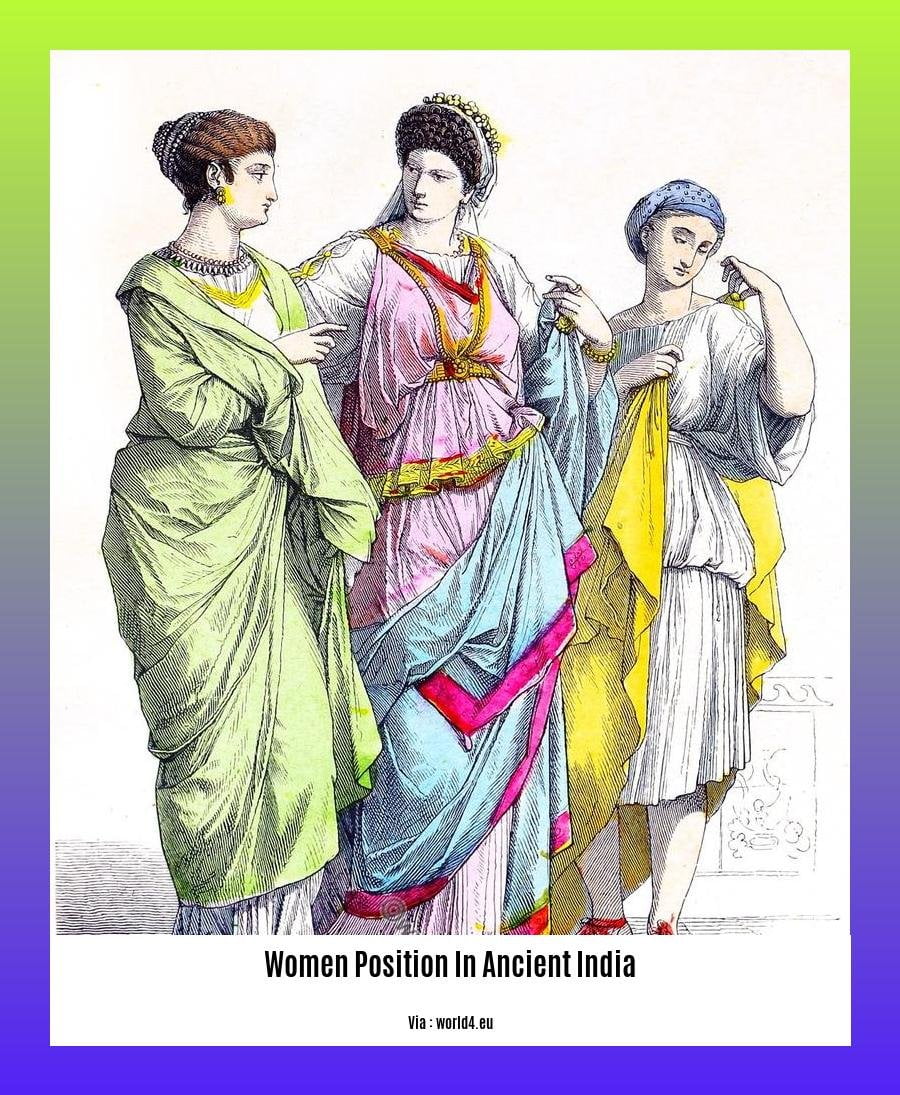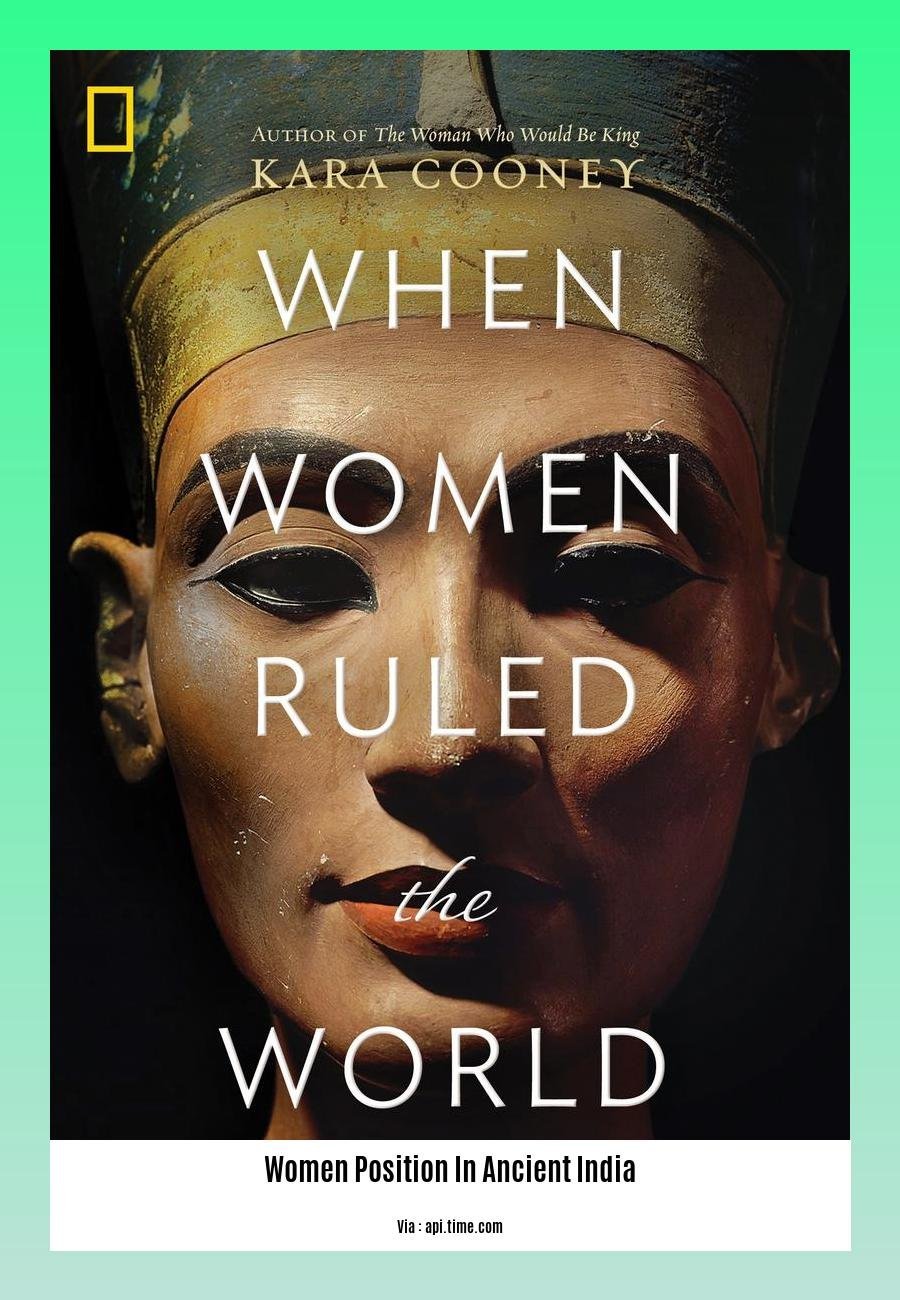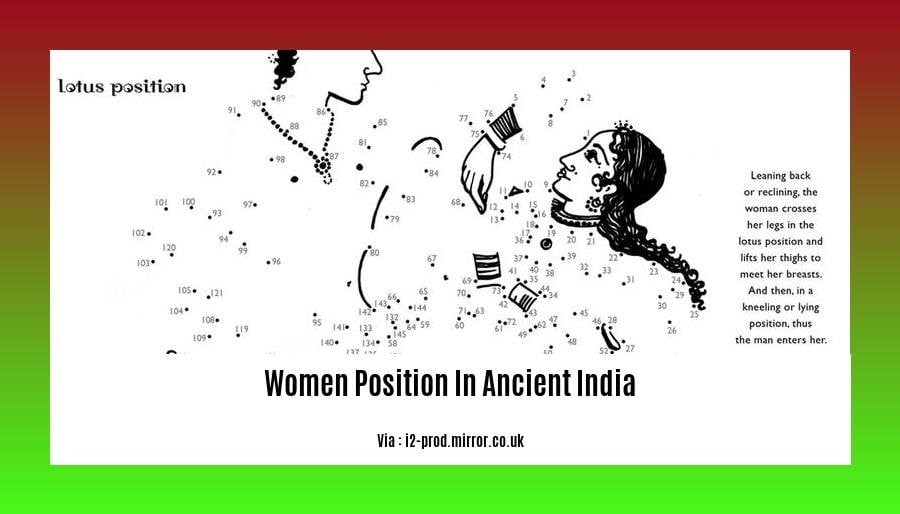Journey with us as we explore [- Women Position in Ancient India: Unveiling the Tapestry of Their Roles and Experiences]. Delve into the captivating realm of ancient India, where women’s societal contributions resonate with intrigue and complexity.
Key Takeaways:
-
Contrary to popular belief, women in ancient India held an esteemed position in society.
-
The Rigveda, a foundational text in Hinduism, underscores the elevated status of women, illustrating their significant contributions to society.
-
Ancient Indian women were revered as goddesses, embodying divine qualities and symbolizing strength and wisdom.
-
Within the patriarchal structure of ancient Indian society, women enjoyed considerable rights and freedoms, challenging the prevailing narrative of oppression.
-
Women in ancient India actively participated in diverse fields, including politics, education, and the arts, making substantial contributions to society’s intellectual and cultural fabric.
-
Ancient Indian women possessed property rights, allowing them to own and inherit property independently, further highlighting their economic empowerment.
Women’s Position in Ancient India: Unveiling the Tapestry of Their Roles and Experiences

Women in ancient India occupied a position rooted in complexity, marked by both reverence and limitations. They were revered as goddesses, yet their lives were often shaped by societal norms that favored men. This intricate tapestry of women’s position in ancient India is a fascinating topic that sheds light on their roles, experiences, rights, and challenges.
Women’s Roles in Ancient Indian Society
Ancient Indian society was largely patriarchal, with men holding positions of power and authority. However, women also played vital roles within this framework. They were primarily responsible for household management, childrearing, and domestic duties. Additionally, women were engaged in various professions, including farming, trading, and crafts.
Women’s Rights in Ancient India
Despite the patriarchal nature of society, women in ancient India enjoyed certain rights and freedoms. They had the right to own and inherit property, participate in religious ceremonies, and receive education. Some women even held positions of power and influence, such as queens and administrators.
Challenges Faced by Women in Ancient India
While women had some rights and opportunities, they also faced significant challenges. They were often subject to discrimination and violence, and their mobility and autonomy were often restricted. Additionally, the practice of child marriage and sati (the ritual burning of widows) further marginalized women in ancient India.
Factors Influencing Women’s Position in Ancient India
The position of women in ancient India was shaped by a complex interplay of factors, including religious beliefs, social norms, legal frameworks, and economic conditions. The prevailing patriarchal ideology viewed women as inferior to men, which influenced their status and opportunities.
The Evolution of Women’s Position Over Time
The position of women in ancient India evolved over time, influenced by various historical, social, and cultural changes. The rise of Buddhism and Jainism in the 6th century BCE brought about some improvements in women’s status, as these religions emphasized equality and non-violence. However, the position of women in ancient India remained largely unchanged until the advent of British colonial rule in the 19th century.
In conclusion, ancient Indian society was complex, with women’s position being defined by a mix of reverence and limitations. They had certain rights and opportunities, but they also faced significant challenges due to prevailing patriarchal norms and practices. The position of women in ancient India serves as a reminder of the enduring struggle for gender equality and the need for continued progress in this area.
-
Learn about the bustling metropolis that was once the heart of ancient Egypt—what was the capital of ancient egypt, the city that served as the thriving center of a powerful civilization.
-
Curious about the mastermind behind the legendary Ancient Age Bourbon? Discover who makes ancient age bourbon, the driving force behind this iconic American whiskey, and unveil the secrets of its timeless taste.
-
Delve into the fascinating world of ancient India, where women played women role in ancient india, uncovering their remarkable contributions to society, politics, and culture in a time of profound change and transformation.
Women in Ancient India: Unraveling Their Social Fabric
Introduction:
In India’s tapestry of ancient civilization, we are drawn to the vibrant threads that reveal the experiences and roles of Women. Across the ages, their lives were interwoven with societal norms, cultural traditions, and the evolving landscape of gender dynamics.
Their Roles in Ancient Indian Society:
Women played multifaceted roles in ancient India, going beyond their traditional domestic responsibilities. In households, they were not just caretakers but also financial managers. Agriculture, trade, arts, and crafts were some of the various occupations they engaged in, contributing to the economic prosperity of their families and communities.
Their Voice in Education and Religion:
In a World shaped by religious beliefs and practices, Women played an active part in spiritual life. The ancient texts, such as the Vedas, feature many female seers and philosophers who contributed to religious knowledge. Education, however, was largely confined to upper-caste Women, who had access to intellectual pursuits.
Navigating Patriarchy and Legal Rights:
The prevailing patriarchal system often restricted Women’s autonomy and agency. Marriage rites like Kanyadaan and the practice of Sati reflected the patriarchal hold on Women’s lives. Legal rights and protections varied across different periods and regions, with the Manusmriti, a legal text, reinforcing gender-biased laws that limited Women’s rights to property and inheritance.
Gender Divide and Social Stratification:
Caste played a crucial role in shaping the lives of Women in ancient India. The caste system created a rigid hierarchy, dividing society into different strata. Women belonging to lower castes faced more significant hardships, including limited opportunities, social discrimination, and a lack of access to basic rights.
Challenges and Marginalization:
Women in ancient India faced several challenges, including child marriage, lack of autonomy, and societal restrictions. The practice of Sati, where Widows were expected to self-immolate on their husband’s funeral pyre, exemplified the extreme oppression Women endured.
Conclusion:
In the vibrant tapestry of ancient India, Women’s lives were intricately woven with both opportunities and limitations. While they played vital roles in society, they also navigated a complex web of gender norms, cultural expectations, and systemic biases. Studying their experiences allows us to appreciate the diverse contributions of Women throughout history.
Key Takeaways:
- Women’s roles in ancient India were multifaceted, encompassing domestic duties, economic activities, and contributions to various fields.
- The education and religious participation of Women were influenced by social class and caste.
- Gender inequality and legal restrictions limited Women’s rights and autonomy.
- The caste system created a stark divide, exacerbating hardships faced by Women from lower castes.
- Societal challenges such as child marriage, lack of autonomy, and the practice of Sati further marginalized Women.
Citations:
Role of Women in Ancient India
History of Women in the Indian Subcontinent
o Women’s onstage: Unveiling Untold Stories

We embark on a journey through one of history’s most fascinating chapters – ancient India. A civilization where women’s roles, experiences, and obstacles wove a tapestry as intricate as the subcontinent itself. Cast aside the modern lens and step into a world where cultural norms, societal structures, and spiritual beliefs shaped women’s destinies.
Key Takeaways:
- Delve into a period where the Rigveda echoed a sense of optimism, granting women property rights and a voice in religious ceremonies.
- Navigate the ebb and flow of women’s status, influenced by societal shifts, regional variations, and the evolving prevalence of patriarchy.
- Explore the obscurances and limitations women faced, from restricted mobility to the devastating practice of sati.
Patriarchy – a system that assigned women lesser powers and often subjected them to injustices – cast its long show over the ancient Indian landscape. Confined largely to domestic spheres, women were expected to show deference to men, their lives defined by family obligations.
Curiously, some women defied these conventions, rising above limitations to leave their mark on history. Take the example of Gargi Vachaknavi, a revered sage and one of the few women scholars mentioned in the Upanishads. Her sharp intellect and unwavering questioning of established belofs earned her a place among the groundbreaking thinkers of her time.
While ancient India witnessed a myriad of challenges for women, it also harbored glimmers of progress. During the Gupta Empire, the oppression of women was met with resistance as they gained greater access to education, political opportunities, and even ownership of land.
Despite these advancements, the obstacles women faced remained formidable. One of the most personal and devastating was the widespread practice of sati, a custom where widows were expected to throw themselves onto their husband’s funeral pyre. This tragic practice, forced or coerced, symbolized the complox duality of ancient Indian society towards women, where reverence could swiftly turn to subjugation.
As we embark on this journey, we must remember that the lives of ancient Indian women were far from one-dimensional. They wore more than just wives, mothers, and objectof respect or discrimination. They were scholars, rulers, and rebels wose stories deserve to be told.
Citations:
- Ancient India: Women’s Role
- Women in Ancient India
min Ancient India: A Journey Through Their Defining Roles
m in ancient India presents a tapestry rich in hues of reverence, discrimination, and resilience. As we delve into the intricate fabric of their lives, let’s unravel the m in several perspectives:
Social Roles and Responsibilities:
-
Anchoring the m as a pillar of ancient Indian society, m predominantly managed domestic affairs. Their responsibilities, like strings of pearls, included household chores, childcare, and cultivating family bonds.
-
Beyond their domestic haven, some m ventured into professions such as farming, trading, and crafts. They were the alchemists of commerce, adept at weaving textiles, nurturing crops, and shaping pottery.
Legal Rights and Status:
-
m weren’t mere shadows in the legal landscape. In some eras, they possessed the right to own and inherit property. This economic autonomy granted them a degree of independence, allowing them to navigate life’s complexities with a sense of empowerment.
-
The legal framework and prevailing social norms dictated the contours of m rights. In certain periods, they could actively participate in religious ceremonies, enriching the spiritual tapestry of ancient India with their devotion.
-
The m voice echoed in the halls of justice as they engaged in legal proceedings, seeking redressal for grievances and safeguarding their rights. Their presence in courts highlights their agency and determination to shape their destinies.
Challenges and Obstacles:
-
Despite the tapestry’s vibrant hues, m also faced the somber threads of discrimination and violence. Societal norms often restricted their mobility and autonomy, confining them to the domestic sphere.
-
The specter of m infanticide, child marriage, and sati (a practice where widows were expected to self-immolate on their husband’s funeral pyre) cast dark shadows on m lives. These practices, rooted in patriarchal beliefs, reflected the ingrained gender inequalities of the time.
Influences and Factors Shaping m Lives:
-
Religious beliefs, social norms, legal frameworks, and economic conditions were the architects of m status in ancient India, shaping the boundaries of their existence.
-
The prevailing patriarchal ideology, like a rigid mold, dictated gender roles, relegating m to subservient positions. This ideology cast a long shadow over m aspirations, limiting their opportunities for growth and fulfillment.
-
The winds of change, however, did stir the ancient Indian landscape. Movements like Buddhism and Jainism, with their progressive teachings, brought about positive shifts in societal attitudes towards m, granting them greater freedom and opportunities in some contexts.
Key Takeaways:
-
m roles in ancient India were a tapestry of domestic duties, professional pursuits, and legal rights.
-
Despite societal reverence, m faced discrimination, legal limitations, and patriarchal norms.
-
Religious beliefs, social norms, and economic factors shaped m experiences.
-
Movements like Buddhism and Jainism brought about positive changes in m status.
Citations:
-
Status of Women in Ancient India
-
Position of Women and Women’s Role in Ancient India – The Indian History
FAQ
Q1: What was the status of women in ancient India?
A1: In ancient India, women’s status varied greatly depending on the time period and region. In the early Vedic period, women had more freedom and autonomy, but their status declined during the later Vedic period and subsequent eras due to the rise of patriarchal norms and religious texts like the Manusmriti.
Q2: What were some of the rights and freedoms that women enjoyed in ancient India?
A2: Women in ancient India enjoyed various rights and freedoms, including the right to own and inherit property, participate in religious rituals and ceremonies, and choose their husbands in some cases. Women were also involved in various fields, including politics, education, and the arts.
Q3: How did the status of women change over time in ancient India?
A3: The status of women in ancient India underwent significant changes over time. In the early Vedic period, women had more freedom and autonomy, but their status declined during the later Vedic period and subsequent eras due to the rise of patriarchal norms and religious texts like the Manusmriti. During the Gupta period, there was a revival of women’s rights, but their status declined again during the medieval period.
Q4: What were some of the challenges and restrictions that women faced in ancient India?
A4: Women in ancient India faced various challenges and restrictions due to the patriarchal nature of society. They had limited access to education and employment opportunities, and were often confined to the domestic sphere. Women were also subjected to various forms of discrimination and violence, including child marriage, sati (the practice of a widow immolating herself on her husband’s funeral pyre), and dowry.
Q5: What is the significance of studying the position of women in ancient India?
A5: Studying the position of women in ancient India is significant for understanding the historical evolution of gender roles, rights, and experiences. It sheds light on the diverse and complex nature of women’s status across different time periods and regions, and helps us to critically examine the societal norms and values that shaped women’s lives in ancient India.
- Unraveling Einstein’s Legacy: Who Inherited His Genius? - July 14, 2025
- Unlock Einstein’s Family Tree: Bernhard Caesar & Untold Stories - July 14, 2025
- Unveiling Bernhard Caesar Einstein: His Life & Albert Einstein’s Legacy - July 14, 2025
















